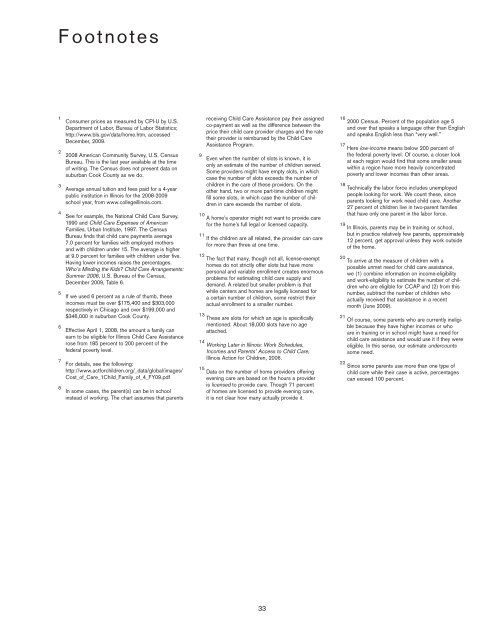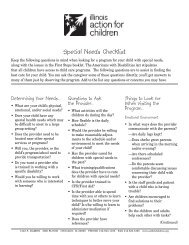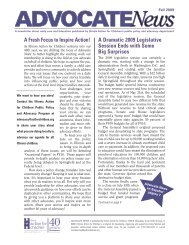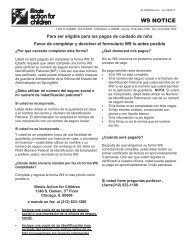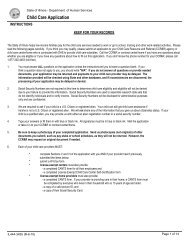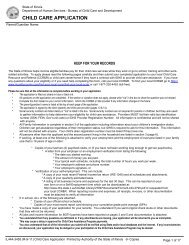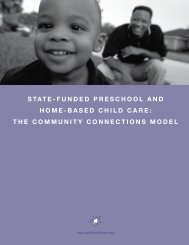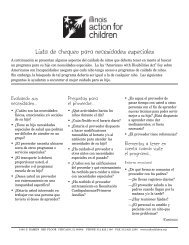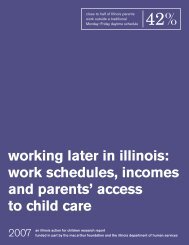child care in cook county - Illinois Action for Children
child care in cook county - Illinois Action for Children
child care in cook county - Illinois Action for Children
You also want an ePaper? Increase the reach of your titles
YUMPU automatically turns print PDFs into web optimized ePapers that Google loves.
Footnotes1 Consumer prices as measured by CPI-U by U.S.Department of Labor, Bureau of Labor Statistics;http://www.bls.gov/data/home.htm, accessedDecember, 2009.2 2008 American Community Survey, U.S. CensusBureau. This is the last year available at the timeof writ<strong>in</strong>g. The Census does not present data onsuburban Cook County as we do.3 Average annual tuition and fees paid <strong>for</strong> a 4-yearpublic <strong>in</strong>stitution <strong>in</strong> Ill<strong>in</strong>ois <strong>for</strong> the 2008-2009school year, from www.collegeill<strong>in</strong>ois.com.4 See <strong>for</strong> example, the National Child Care Survey,1990 and Child Care Expenses of AmericanFamilies, Urban Institute, 1997. The CensusBureau f<strong>in</strong>ds that <strong>child</strong> <strong>care</strong> payments average7.0 percent <strong>for</strong> families with employed mothersand with <strong>child</strong>ren under 15. The average is higherat 9.0 percent <strong>for</strong> families with <strong>child</strong>ren under five.Hav<strong>in</strong>g lower <strong>in</strong>comes raises the percentages.Who’s M<strong>in</strong>d<strong>in</strong>g the Kids? Child Care Arrangements:Summer 2006, U.S. Bureau of the Census,December 2009, Table 6.5 If we used 6 percent as a rule of thumb, these<strong>in</strong>comes must be over $175,400 and $303,000respectively <strong>in</strong> Chicago and over $199,000 and$346,000 <strong>in</strong> suburban Cook County.6 Effective April 1, 2008, the amount a family canearn to be eligible <strong>for</strong> Ill<strong>in</strong>ois Child Care Assistancerose from 185 percent to 200 percent of thefederal poverty level.7 For details, see the follow<strong>in</strong>g:http://www.act<strong>for</strong><strong>child</strong>ren.org/_data/global/images/Cost_of_Care_1Child_Family_of_4_FY09.pdf8 In some cases, the parent(s) can be <strong>in</strong> school<strong>in</strong>stead of work<strong>in</strong>g. The chart assumes that parentsreceiv<strong>in</strong>g Child Care Assistance pay their assignedco-payment as well as the difference between theprice their <strong>child</strong> <strong>care</strong> provider charges and the ratetheir provider is reimbursed by the Child CareAssistance Program.9 Even when the number of slots is known, it isonly an estimate of the number of <strong>child</strong>ren served.Some providers might have empty slots, <strong>in</strong> whichcase the number of slots exceeds the number of<strong>child</strong>ren <strong>in</strong> the <strong>care</strong> of these providers. On theother hand, two or more part-time <strong>child</strong>ren mightfill some slots, <strong>in</strong> which case the number of <strong>child</strong>ren<strong>in</strong> <strong>care</strong> exceeds the number of slots.10 A home’s operator might not want to provide <strong>care</strong><strong>for</strong> the home’s full legal or licensed capacity.11 If the <strong>child</strong>ren are all related, the provider can <strong>care</strong><strong>for</strong> more than three at one time.12 The fact that many, though not all, license-exempthomes do not strictly offer slots but have morepersonal and variable enrollment creates enormousproblems <strong>for</strong> estimat<strong>in</strong>g <strong>child</strong> <strong>care</strong> supply anddemand. A related but smaller problem is thatwhile centers and homes are legally licensed <strong>for</strong>a certa<strong>in</strong> number of <strong>child</strong>ren, some restrict theiractual enrollment to a smaller number.13 These are slots <strong>for</strong> which an age is specificallymentioned. About 18,000 slots have no ageattached.14 Work<strong>in</strong>g Later <strong>in</strong> Ill<strong>in</strong>ois: Work Schedules,Incomes and Parents’ Access to Child Care,Ill<strong>in</strong>ois <strong>Action</strong> <strong>for</strong> <strong>Children</strong>, 2006.15 Data on the number of home providers offer<strong>in</strong>geven<strong>in</strong>g <strong>care</strong> are based on the hours a provideris licensed to provide <strong>care</strong>. Though 71 percentof homes are licensed to provide even<strong>in</strong>g <strong>care</strong>,it is not clear how many actually provide it.16 2000 Census. Percent of the population age 5and over that speaks a language other than Englishand speaks English less than “very well.”17 Here low-<strong>in</strong>come means below 200 percent ofthe federal poverty level. Of course, a closer lookat each region would f<strong>in</strong>d that some smaller areaswith<strong>in</strong> a region have more heavily concentratedpoverty and lower <strong>in</strong>comes than other areas.18 Technically the labor <strong>for</strong>ce <strong>in</strong>cludes unemployedpeople look<strong>in</strong>g <strong>for</strong> work. We count these, s<strong>in</strong>ceparents look<strong>in</strong>g <strong>for</strong> work need <strong>child</strong> <strong>care</strong>. Another27 percent of <strong>child</strong>ren live <strong>in</strong> two-parent familiesthat have only one parent <strong>in</strong> the labor <strong>for</strong>ce.19 In Ill<strong>in</strong>ois, parents may be <strong>in</strong> tra<strong>in</strong><strong>in</strong>g or school,but <strong>in</strong> practice relatively few parents, approximately12 percent, get approval unless they work outsideof the home.20 To arrive at the measure of <strong>child</strong>ren with apossible unmet need <strong>for</strong> <strong>child</strong> <strong>care</strong> assistance,we (1) comb<strong>in</strong>e <strong>in</strong><strong>for</strong>mation on <strong>in</strong>come-eligibilityand work-eligibility to estimate the number of <strong>child</strong>renwho are eligible <strong>for</strong> CCAP and (2) from thisnumber, subtract the number of <strong>child</strong>ren whoactually received that assistance <strong>in</strong> a recentmonth (June 2009).21 Of course, some parents who are currently <strong>in</strong>eligiblebecause they have higher <strong>in</strong>comes or whoare <strong>in</strong> tra<strong>in</strong><strong>in</strong>g or <strong>in</strong> school might have a need <strong>for</strong><strong>child</strong> <strong>care</strong> assistance and would use it if they wereeligible. In this sense, our estimate undercountssome need.22 S<strong>in</strong>ce some parents use more than one type of<strong>child</strong> <strong>care</strong> while their case is active, percentagescan exceed 100 percent.33


